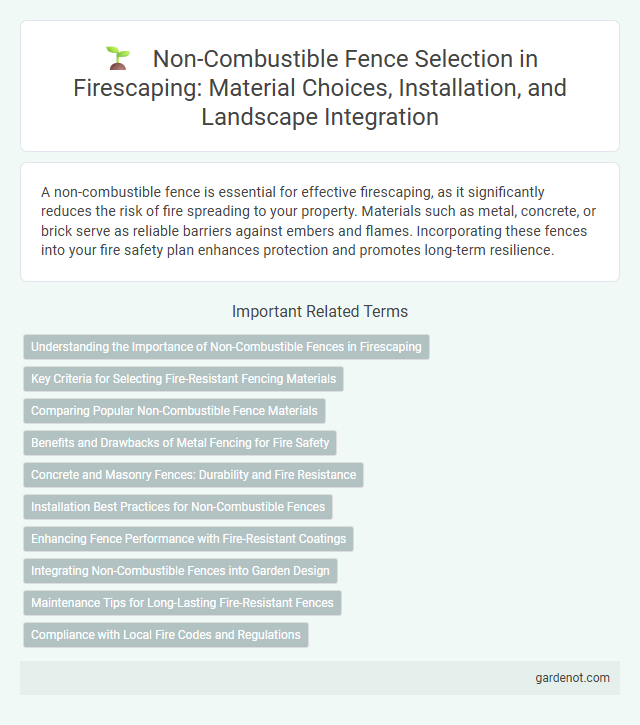A non-combustible fence is essential for effective firescaping, as it significantly reduces the risk of fire spreading to your property. Materials such as metal, concrete, or brick serve as reliable barriers against embers and flames. Incorporating these fences into your fire safety plan enhances protection and promotes long-term resilience.
Understanding the Importance of Non-Combustible Fences in Firescaping
Non-combustible fences, made from materials such as metal, brick, or concrete, play a critical role in firescaping by creating effective firebreaks that reduce the spread of wildfires. Their fire-resistant properties help protect homes and landscapes from radiant heat and flying embers, significantly enhancing overall fire safety. Incorporating non-combustible fencing into a strategic firescaping plan is essential for mitigating wildfire risks and safeguarding property.
Key Criteria for Selecting Fire-Resistant Fencing Materials
Fire-resistant fencing materials must prioritize non-combustibility, high heat tolerance, and durability under extreme conditions to effectively resist ignition during wildfires. Key criteria include using materials such as steel, concrete, and fiber cement, which do not burn or melt easily, alongside proper installation to minimize gaps and potential fuel sources. Selecting fencing products certified for fire resistance and ensuring compatibility with local fire codes enhances safety and long-term performance in fire-prone areas.
Comparing Popular Non-Combustible Fence Materials
Non-combustible fence materials such as metal, concrete, and brick offer superior fire resistance compared to wood or vinyl, reducing the risk of fire spread in high-risk areas. Steel fences provide durability and minimal maintenance, while concrete offers excellent thermal insulation and a robust barrier against flames. Brick fences combine aesthetic appeal with fireproof qualities but typically involve higher installation costs and longer construction times.
Benefits and Drawbacks of Metal Fencing for Fire Safety
Metal fencing offers significant benefits for firescaping, including its non-combustible nature that prevents ignition during wildfires, enhancing overall property fire resistance. This type of fencing is durable, requires minimal maintenance, and does not contribute to fuel loads near structures, effectively serving as a firebreak. However, drawbacks include higher initial installation costs and less aesthetic variety compared to wood, which may affect homeowner preferences despite its superior fire safety performance.
Concrete and Masonry Fences: Durability and Fire Resistance
Concrete and masonry fences offer exceptional durability and fire resistance, making them ideal choices for firescaping. Their non-combustible materials effectively prevent flame spread, providing a robust barrier against wildfires. These fences also require minimal maintenance while enhancing property safety and resilience in fire-prone areas.
Installation Best Practices for Non-Combustible Fences
Proper installation of non-combustible fences requires securing posts in concrete footings at least 24 inches deep to withstand extreme heat and prevent shifting. Using metal brackets and corrosion-resistant fasteners ensures structural integrity while minimizing combustible materials that could ignite during a fire event. Maintaining a minimum clearance of 6 inches between the fence and ground allows for airflow and reduces potential fuel accumulation, enhancing overall fire resistance.
Enhancing Fence Performance with Fire-Resistant Coatings
Fire-resistant coatings significantly enhance the performance of non-combustible fences by creating an additional protective barrier that slows heat transfer and prevents ignition. These coatings increase the fence's resistance to radiant heat and direct flame exposure, extending survival time during wildfires. Applying intumescent or ceramic-based fire retardant finishes ensures long-lasting durability and improved fire safety for surrounding landscapes and property.
Integrating Non-Combustible Fences into Garden Design
Non-combustible fences, made from materials like metal, concrete, or fiber cement, enhance firescaping by creating effective firebreaks around garden perimeters. Integrating these fences with strategically placed fire-resistant plants and gravel pathways optimizes garden safety while maintaining aesthetic appeal. This combination reduces the risk of ember ignition and supports a sustainable, low-flammability landscape design.
Maintenance Tips for Long-Lasting Fire-Resistant Fences
Non-combustible fences, made from materials like metal, fiber cement, or masonry, require regular inspections to ensure no damage or gaps compromise their fire resistance. Cleaning debris and vegetation buildup at the fence base minimizes potential fuel sources and maintains the integrity of the fire barrier. Applying protective coatings or sealants designed for fire-resistant materials extends fence durability and enhances long-term fire protection.
Compliance with Local Fire Codes and Regulations
Non-combustible fences made from materials such as metal, masonry, or concrete significantly enhance firescaping efforts by adhering to local fire codes and regulations designed to prevent fire spread. These fences often meet strict criteria for flame resistance and heat endurance, ensuring compliance with municipal and state fire safety standards. Proper installation of non-combustible fences not only reduces wildfire risk but also supports community fire mitigation plans mandated by governing authorities.
Non-combustible fence Infographic

 gardenot.com
gardenot.com